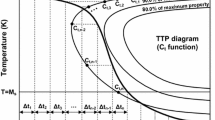Abstract
In this paper, the investigation of thin flash generation in precision forging process of an aluminum long flat part is described. The aim was to derive a predictive simulation method for thin flash generation in order to increase both process and part quality in the future. The forging processes were varied by use of different preforms with equal volumes but different mass distributions while using the same final part geometry. The experimentally forged parts were analyzed concerning the amount and part area of the generated thin flash. The conducted FE simulations were analyzed concerning the hydrostatic pressure values p in the part areas near to the tool gap between upper and lower die immediately before form-filling. For a more detailed comparison, single p values were included to hydrostatic pressure functions P. The comparison between the P functions and the experimentally determined thin flash height shows, that high pressure values as well as high gradients of the P functions indicate less thin flash generation. The method therefore allows a qualitative prediction of thin flash generation. It can provide two kind of information. First: The prediction of the specific locations where thin flash is likely to occur in one final part by use of one single preform. Second: The qualitative prediction of the specific final part areas were thin flash is likely to occur depending on different preform geometries. This method will decreases the necessity of time-consuming forging trials and can shorten the preform designing process in the future.






Similar content being viewed by others
Abbreviations
- Tb :
-
Billet temperature
- vf :
-
Forming velocity/press speed
- wg :
-
Width of gap
- T:
-
Temperature
- ε:
-
Effective strain
- σf :
-
Flow stress
- \(\dot {\varepsilon }\) :
-
Stain rate
- A:
-
Solidity
- m1, m9 :
-
Coefficient for dependence of the temperature
- m2 :
-
Coefficient for dependence of strain hardening
- m3 :
-
Coefficient for dependence of equivalent strain rate
- m4 :
-
Coefficient for dependence of equivalent strain
- m5 :
-
Coefficient for term coupling temperature and stress
- m7 :
-
Coefficient for term sensitivity of material to stress
- m8 :
-
Coefficient for term coupling temperature and stress rate
- τR :
-
Friction stress
- σN :
-
Normal stress
- µ:
-
Coefficient of friction
- m:
-
Factor of friction
- k:
-
Shear yield strength
- Tdie :
-
Initial die temperature
- Ta :
-
Ambient temperature
- U:
-
Thermal effusivity
- αT :
-
Heat transfer coefficient
- p:
-
Hydrostatic pressure
- P:
-
Hydrostatic pressure function.
- l:
-
Length of the measuring line
References
Behrens B-A, Suchmann P, Schott A (2008) Warm forging: new forming sequence for the manufacturing of long flat pieces, Production Engineering, Research and Development, vol 2, no 3. Springer, Berlin 3, 381–389
Doege E (2018) Mehrfachwirkende Stempelwerkzeuge (DO 190/119-3), (2004) report German Research Foundation (DFG)
Siegert K, Ringhand D (1994) Flashless and precision forging of connecting rods from P/M aluminum alloys. J Mater Process Technol 46:157–167
Kim S-Y, Tsuruoka K, Yamamoto T (2014) Effect of forming speed in precision forging process evaluated using CAE technology and high performance servo-press machine. Procedia Eng 81:2415–2420
Bin Z et al (2015) Design of relief-cavity in closed-precision forging of gears, J. Cent. South Univ., vol 20, no 4. Central South University Press and Springer-Verlag, Berlin, Heidelberg, 1287–1297
Zhang Y, Jian S, Zha Y, Shan D (2013) Isothermal precision forging of complex–shape rotating disk of aluminum alloy based on processing map and digitized technology. Mater Sci Eng A 580:294–304
Farhoumand A, Ebrahimi R (2009) Analysis of forward–backward-radial extrusion process. Mater Design 30:2152–2157
Langner J, Stonis M, Behrens B-A (2015) Experimental investigation of a variable flash gap regarding material flow and influence of trigger forces, Production Engineering, Research and Development, vol 9, no 3. Springer, New York, 289–297
Richter J et al (2017) Analysis of an aluminum forging process in completely enclosed dies considering the numerical predicition of thin flash generation in small gaps. J Mech Sci Technol 31(7):3429–3435
Richter J et al (2017) Quality optimization for aluminum precision forging processes in completely enclosed dies of long forging parts by prediction and avoidance of thin flash generation. Procedia Eng Proc ICTP 207:484–489
Hensel A, Spittel T (1978) Kraft- und Arbeitsbedarf bildsamer Formgebungsverfahren, Deutscher Verlag für Grundstoffindustrie
Altan T, Vazquez V (1996) Numerical process simulation for tool and process design in bulk metal forming. CIRP Ann Manuf Technol 45(2):599–615
Behrens B-A et al (2015) Advanced friction modeling for bulk metal forming processes. Prod Eng Res Dev 5(6):621–627
Springorum F (2017) Gegenwart und Zukunft der Massivumformung, Conference proceedings 22. Umformtechnisches Kolloquium Hannover, editor.: Prof. Dr.-Ing. Behrens, PZH Verlag, pp 1–15
Acknowledgements
The Research Project “ProGrAl” (STO 1011/4 − 1) has been funded by the German Research Foundation (DFG). The authors would like to thank the German Research Foundation (DFG) for the financial and organizational support of this Project. The authors declare that they have no conflict of interest.
Author information
Authors and Affiliations
Corresponding author
Rights and permissions
About this article
Cite this article
Richter, J., Stonis, M., Langner, J. et al. Development of a predictive simulation method for thin flash generation in flashless precision forging processes of aluminum parts using FEA and experiments. Prod. Eng. Res. Devel. 12, 419–429 (2018). https://doi.org/10.1007/s11740-018-0803-6
Received:
Accepted:
Published:
Issue Date:
DOI: https://doi.org/10.1007/s11740-018-0803-6




